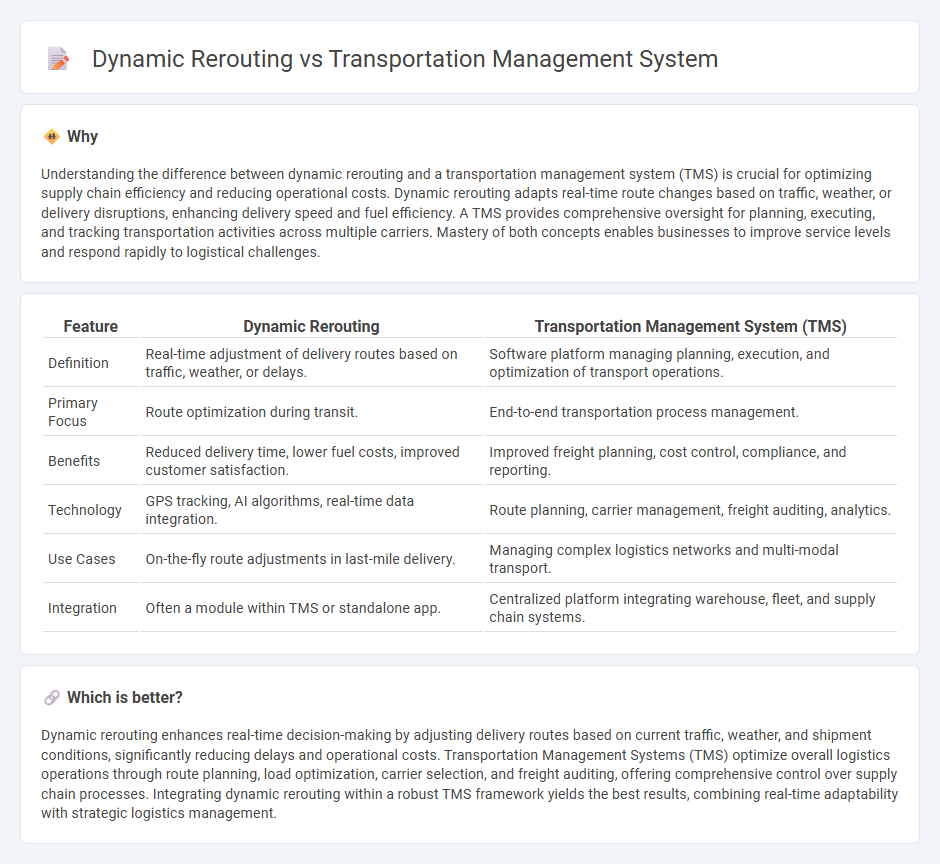
Dynamic rerouting enhances logistics efficiency by real-time adjusting delivery paths based on traffic, weather, and order changes, optimizing fuel use and reducing delays. Transportation Management Systems (TMS) integrate planning, execution, and monitoring of freight, providing comprehensive control over shipment scheduling, carrier selection, and cost management. Explore how combining dynamic rerouting with TMS can revolutionize your logistics strategy.
Why it is important
Understanding the difference between dynamic rerouting and a transportation management system (TMS) is crucial for optimizing supply chain efficiency and reducing operational costs. Dynamic rerouting adapts real-time route changes based on traffic, weather, or delivery disruptions, enhancing delivery speed and fuel efficiency. A TMS provides comprehensive oversight for planning, executing, and tracking transportation activities across multiple carriers. Mastery of both concepts enables businesses to improve service levels and respond rapidly to logistical challenges.
Comparison Table
| Feature | Dynamic Rerouting | Transportation Management System (TMS) |
|---|---|---|
| Definition | Real-time adjustment of delivery routes based on traffic, weather, or delays. | Software platform managing planning, execution, and optimization of transport operations. |
| Primary Focus | Route optimization during transit. | End-to-end transportation process management. |
| Benefits | Reduced delivery time, lower fuel costs, improved customer satisfaction. | Improved freight planning, cost control, compliance, and reporting. |
| Technology | GPS tracking, AI algorithms, real-time data integration. | Route planning, carrier management, freight auditing, analytics. |
| Use Cases | On-the-fly route adjustments in last-mile delivery. | Managing complex logistics networks and multi-modal transport. |
| Integration | Often a module within TMS or standalone app. | Centralized platform integrating warehouse, fleet, and supply chain systems. |
Which is better?
Dynamic rerouting enhances real-time decision-making by adjusting delivery routes based on current traffic, weather, and shipment conditions, significantly reducing delays and operational costs. Transportation Management Systems (TMS) optimize overall logistics operations through route planning, load optimization, carrier selection, and freight auditing, offering comprehensive control over supply chain processes. Integrating dynamic rerouting within a robust TMS framework yields the best results, combining real-time adaptability with strategic logistics management.
Connection
Dynamic rerouting leverages real-time data to adjust transportation routes instantly, enhancing the efficiency of a transportation management system (TMS). A TMS integrates various logistics processes, optimizing shipping schedules, reducing fuel consumption, and improving delivery accuracy through dynamic route adjustments. This connectivity increases supply chain responsiveness and lowers operational costs by minimizing delays caused by traffic or unforeseen disruptions.
Key Terms
**Transportation Management System:**
Transportation Management Systems (TMS) optimize logistics by integrating planning, execution, and tracking of transport operations, enhancing efficiency and cost-effectiveness. These systems provide comprehensive route planning, carrier selection, and freight auditing, enabling businesses to streamline supply chain workflows and improve delivery performance. Explore how TMS solutions transform supply chain management and boost operational productivity.
Route Optimization
Transportation management systems integrate multiple logistics functions, including route optimization, to enhance overall supply chain efficiency by analyzing traffic patterns, delivery windows, and vehicle capacities. Dynamic rerouting specifically targets real-time adjustments to routes based on traffic conditions, accidents, or delays, providing agility but limited scope compared to comprehensive systems. Explore more to understand how combining these approaches can drive superior route optimization in logistics.
Carrier Selection
Transportation management systems streamline carrier selection by integrating data on cost, performance, and capacity to optimize shipment assignments. Dynamic rerouting enhances this process by using real-time traffic and carrier status updates to adjust routes and select alternate carriers promptly, improving delivery efficiency and reducing delays. Explore how combining TMS capabilities with dynamic rerouting advances carrier selection and overall supply chain agility.
Source and External Links
What is a Transportation Management System (TMS)? | Manhattan - A TMS is supply chain software that manages, plans, and optimizes logistics services for transporting goods, offering benefits like route optimization, real-time visibility, fleet coordination, automation, and cost reduction.
Transportation management system - Wikipedia - A TMS is a subset of supply chain management focused on transportation operations that interfaces with ERP and warehouse systems to plan routes, select transport modes, execute shipments, and support freight auditing and payment.
Best Transportation Management Systems Reviews 2025 - Gartner - Gartner defines TMS as software supporting multimodal transport planning and execution with features including order intake, shipment planning, carrier selection, real-time tracking, analytics, and freight cost settlement.
 dowidth.com
dowidth.com